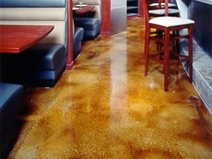- Staining Concrete
- Stamped Concrete
- Concrete Overlays
- Concrete Resurfacing
- Concrete Polishing
- Concrete Dyes
- Colored Concrete
- Indoor Concrete
- Concrete Floors
- Concrete Countertops
- Garage Floor Coatings
- Furniture, Sinks, Fire Bowls
- Basement Floors
- Outdoor Concrete
- Concrete Patios
- Concrete Driveways
- Concrete Pool Decks
- Outdoor Kitchens & Counters
- Outdoor Fireplace
- Concrete Walkways
- Concrete Pavers
- Concrete Walls
- Repair & Maintenance
- Foundation Repair
- Concrete Crack Repair
- Concrete Sealers
- Building with Concrete
- Concrete Homes
- Concrete Basements
- Decorative Concrete
- Fire Resistant
Custom Concrete
Six ways to customize plain concreteColor, style, texture, patterns, borders, design...these are the attributes that make up custom concrete. Nearly any concrete surface can be customized so long as there is no major repair work needed for areas that are heaving, deteriorating or that have large cracks.
What custom concrete is not: Concrete that is uncolored, without texture, and serves only a utilitarian purpose is not custom. Rather, custom concrete includes color, style, texture, patterns, borders, and designs that are part of the concrete's surface.
To learn how to transform your concrete from utilitarian gray to a unique, decorative surface, consider the following six options.
Colored Concrete
Colored concrete is the most popular form of custom concrete. By adding color to concrete, you change plain gray concrete to a type of custom concrete. Colored concrete can be achieved by adding pigment to the concrete mix, called integrally colored concrete, or by applying a coloring agent, known as color hardener, dry shake, or dust on color, to the surface of the concrete when it is first placed. Integral color can be a bit more cost effective, but color hardener provides a wider selection of colors and increased surface durability. No matter which direction you choose, colored concrete is a nice, easy, and cost effective way to customize your next concrete job.
(Photo: Richard Smith Custom Concrete in Canoga Park, CA)
Stamped Concrete
Stamped concrete, also known as patterned or imprinted concrete, is probably the most recognized type of custom concrete. Having started as decorative upgrades on a few custom homes in Carmel, California in the late 1950's, today stamped concrete is available in every corner of the world, in almost every stone, tile or rock texture imaginable. Combining color, texture and pattern, concrete is transformed into a truly custom product that enhances any hardscape or interior space it occupies.
(Photo: Davis Colors in Los Angeles, CA)
Stained Concrete
Stained concrete can be further broken down into categories such as acid staining, dyed concrete, and tinted sealers. While each aforementioned type of stain provides a different color palette and look, what they have in common is that they are applied after the concrete is at least a month old. These products are designed to give almost any type of concrete a custom look and feel after it is placed and cured. These products can produce finishes ranging from translucent to opaque, high gloss to matte. If you are looking for a way to dress up concrete that is already down, then consider one of the many types of concrete stains, dyes or tinted sealers available on the market today.
(Photo: Progressive Hardscapes in Phoenix, AZ)
Decorative Overlays
Decorative overlays are the lesser known, but not any less custom, segment of the decorative concrete world. Having gained popularity in the last ten years, overlays are designed to go over plain or worn concrete surfaces without having to replace the existing concrete. When existing concrete is in good shape structurally, but lacks the look, texture, color or pattern you desire, overlays are a great way to customize without rip out and replace. Surface preparation is the key with any overlay application. Overlays range in thickness from that of a credit card to 1-inch, and can be glass smooth or imprinted to resemble stamped concrete. Most overlays also accept stains, which expands the color, and customization you can achieve even that much more.
(Photo: Meidling Concrete in Spokane, WA)
Concrete Countertops
Concrete countertops and precast concrete describes custom concrete that is poured into a mold to assume certain shapes or forms. Concrete countertops have become quite the rage, with multiple companies specializing in just that one discipline. Precast concrete and concrete countertops combine any number of custom elements to achieve concrete that resembles works of art as much as a countertop, chair, fireplace surround, or bathtub. If you can dream it, it's a pretty good bet custom precast concrete can fill that void - no pun intended.
(Photo: Art and Maison Inc. in Miami, FL)
Polished Concrete
Polished concrete is the latest and hottest trend in custom concrete. Polishing stone has been around since antiquity, so why not polish manmade stone - concrete? With the recent improvements in equipment and process, polished concrete provides a cost effective alternative to other flooring surfaces, primarily for spaces. The process of polishing involves grinding or micro-scratching concrete with subsequently finer diamond pads until the level of gloss and hardness is achieved. At about the midpoint of the process, chemicals that harden and densify the concrete are applied, as well as stains or dyes if a truly custom look is desired. The other benefit of polished concrete is the ease of maintenance, since no topical sealers are applied. If the customized look of polished stone under foot is what you want, then polished concrete provides the solution.
(Photo: Rockerz, Inc in Warrendale, PA )
I hope this overview of custom options gives you a better understanding of what can be done with your concrete. And don't be afraid to mix and match the different segments to create your own custom blend of concrete, color, and style.
Author Chris Sullivan, ConcreteNetwork.com technical expert and vice president of sales and marketing for ChemSystems Inc.










